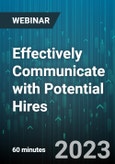The communication between a you and a candidate should help develop rapport, trust, and a working relationship. This cannot be accomplished if the only way you communicate is my text or email. Often that is the way you are most comfortable communicating, but those messages can be easily deleted.
Your goal is to develop rapport with both your candidates and Hiring Authorities that is based on trust. Technology should help you work more efficiently and save time, but your approach to communicating should be a combination of high-tech and high-touch. Prospective hires must feel like you care about them, They can trust you and you will do what you promise. Too often, they feel like all you care about is filling a job, not what is in their best interest.
The training will help you differentiate from other recruiters or Talent Acquisition Professionals by teach you how to present your personal brand. This helps answer the question, “Why should someone respond to you and allow you to help them advance in their career?” Top talent is in high demand and being bombarded by communication from your competitor, so you will learn how to stand out.
Next the training will address why it’s important to utilize all means of communication including the phone. Candidates will respond to you if they feel you can benefit them. They will not respond if your communication is pitching someone you need or want.
When you do successfully have a conversation with a prospective hire, you will also learn why you should never talk more than 1/3 of the time, why you should always ask open-ended questions and how important it is to write down what you are being told into your ATS or CRM.
In addition, this training will teach you the difference between listening and hearing which are very different skills. This is yet another way you can differentiate from others pursuing the same talent. When you become the best listener in the lives of the candidate you represent, communication will become less guarded, and rapport based on trust will continue to improve.
Next you will learn how important your subject line is if you want top talent to open and respond to your email. You will learn a script you can use when leaving voice mail that has a very high response rate. Lastly, you will be provided with sample templates for InMail that will not be ignored.
When your communication efforts work, you must overcome objections. This Webinar addresses the four types of objections and how to effectively overcome them. After you complete this Webinar, you will communicate more effectively, and you will welcome objections because you will view them as a buying sign or a request for more information.
Why you should Attend
Does anyone answer their phone, email or InMail? How can you communicate with the best talent when they have learned to hide behind technology?Have you ever had a candidate send in a resume or cv who seems to be a perfect fit for one of your opportunities, and then they won’t communicate? Have you sent InMail as a result of a referral, only to be ignored? Do you even know what percentage of the email you send are actually opened?
Why should a potential hire respond to you vs. the other individuals who are trying to entice them to respond? What is your personal brand that separates you from others? How can you differentiate yourself in the few seconds you have to impress a potential hire? Your company has a brand, but potential hires are being called by you. If you don’t know the answers these questions, attending this training is a must!
Top talent complains all the time that Recruiters and Talent Acquisition Professionals all say they are different, but when they ask them how, they all say the same things.
When you communicate with a potential hire are you focused on WWD (What We Do) presentations or are you 100% focused on WIIFM (What’s In It For Me) - how you can benefit this person? WWD presentations are not effective with the best talent in today’s competitive job market.
Do you know the difference between listening and hearing because they are very different skills. Selective hearing can sabotage you from effectively communicating which should represent 40% you are talking and 50% you listening.
If you email, voicemail, and InMail are being ignored it’s time to change the way you communicate. In addition, when you do communicate with a potential hire, are you able to overcome objections? If not, that could be sabotaging your efforts to represent the best. If you don’t know the four categories of objections and how to overcome the most common candidate objections, that is just another reason to attend this training.
Areas Covered in the Session
- The impact of “how” you say something
- Three goals when communicating with candidates
- Your Brand which differentiates you from others
- The difference between listening and hearing
- Impact of your subject line when writing email
- Voicemail script that generates responses
- InMail templates that generate responses
- How to effectively overcome objections








